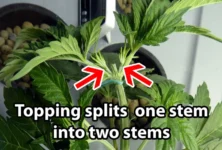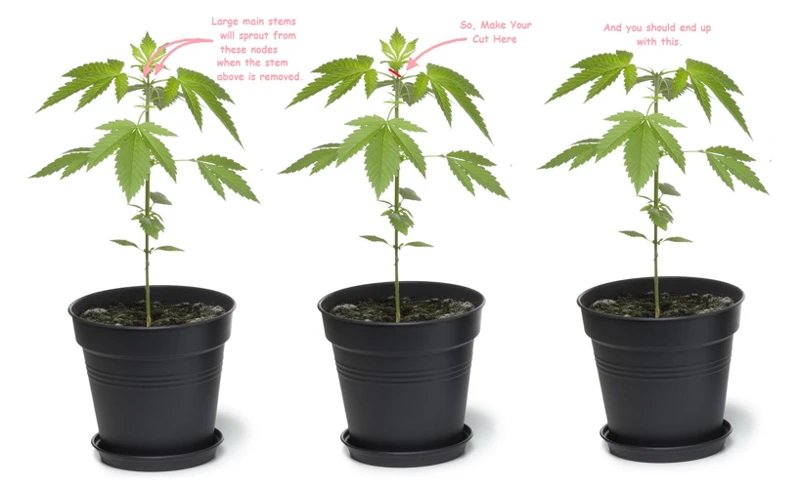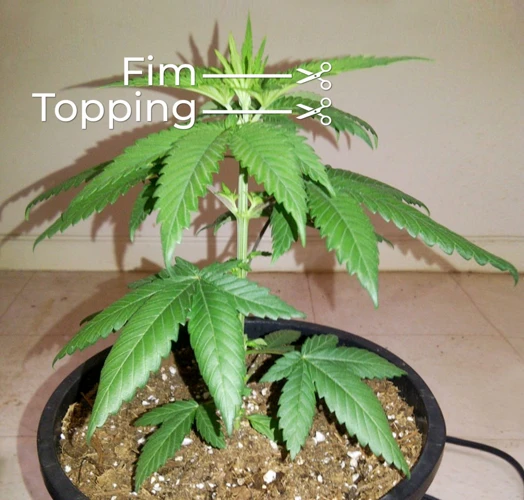
How to Top Cannabis Plants for Better Yields
As cannabis cultivation becomes more popular, so does the interest in advanced pruning techniques like topping. If you’re a beginner or have never heard of topping before, you may be wondering what it is and how it’s done correctly. Topping is a pruning method that involves removing the top of the plant to encourage growth in the lower branches. But how does it work, and what are the benefits of using it? In this article, we’ll dive into the world of topping and give you a step-by-step guide on how to do it correctly. So let’s get started!
What is Topping?
Contents
As a cannabis grower, you may have heard of the term “topping.” Essentially, topping involves removing a portion of the plant’s main stem in order to encourage lateral growth. This process can seem counterintuitive at first, as you’re essentially removing a part of the plant’s structure. However, the benefits of topping are numerous and can drastically improve the overall yield and quality of your cannabis plants. Let’s dive deeper into what exactly topping is and why it’s worth considering for your grow.
The Benefits of Topping
Topping your cannabis plants can provide multiple benefits for your overall growing experience. Here are some of the advantages of topping your plants:
- Increased yield: Topping your cannabis plant will result in two main colas (branches) growing in place of the one that was removed. This means that instead of having one primary cola, you will have two. This will ultimately lead to an increase in the number of flowers that the plant produces, which can increase yield.
- Better light distribution: When your cannabis plant is growing naturally, the top of the plant will receive most of the light, while the bottom of the plant gets little to no light. By topping your plants, you are encouraging the growth of new branches, which will lead to a more even distribution of light throughout the plant. When all parts of the plant are receiving an equal amount of light, it can help increase the production of buds.
- Improved canopy: Topping your plants helps create a more even canopy by spreading out the different branches. This leads to more buds being produced that are of a similar size and quality, which can increase the overall yield of the plant.
- Reduced height: With topping, you can control the height of your plants, which can be beneficial if you have limited space for cultivation. When you cut off the top cola, the plant redirects its energy to growing the other branches instead of upward growth. This will result in a plant that is shorter in height but still has the potential to produce a high yield.
- Controlled growth: When you top your plants, you are controlling their growth. By clipping the top cola, you are forcing the plant to focus its energy on growing the new branches. This allows you to shape the plant as it grows and obtain a desired shape and size. You can also control the timing and frequency of topping, which can be important for timing your harvests.
Topping your plants can ultimately lead to a healthier and more productive plant. However, it is important to properly time and execute the topping process to ensure success.
When to Top
One of the most crucial aspects of topping cannabis plants is determining the right time to do it. With the health and yield of your plants at stake, timing is everything. It can be perplexing to gauge the right moment and ensure that your plants are prepared for topping. Nevertheless, with a bit of preparation and patience, you can reach the right timing and successfully top your cannabis plants. Let’s explore the key points to consider when determining when to top your cannabis plants.
Timing is Key
Timing is one of the most crucial aspects of successful topping. It is important to wait until the plants have at least four to six nodes before topping. Nodes are points on the stem where the leaves grow out. Topping too early could stunt plant growth and prevent it from reaching its full potential. Topping too late could cause the plant to become too bushy and unmanageable.
In addition to waiting for the right node count, timing should also be based on the plant’s growth stage. Topping during the vegetative phase, while the plant is still developing foliage, can promote horizontal growth and help the plant develop a more even canopy. Topping during the flowering phase should be avoided as it can harm the plant’s ability to produce buds.
Once the plant has reached the appropriate node count and growth stage, it is important to prepare the plant for topping. This involves ensuring the plant is properly hydrated and has enough nutrients to support regrowth after topping. The timing of topping can also affect the recovery time for the plant. Topping earlier in the vegetation stage will give the plant more time to recover and develop before entering the flowering phase.
| Timing Tips |
|---|
| Wait for at least 4-6 nodes before topping |
| Avoid topping during flowering phase |
| Prepare plant for topping by ensuring proper hydration and nutrients |
| Topping earlier in vegetative stage allows for more recovery time |
Preparation
Before you top your cannabis plants, there are a few preparations you need to make to ensure that the process goes as smoothly as possible. These preparations include:
| Preparation Steps |
|---|
| 1. Make Sure Your Plants Are Healthy: It’s important to wait until your cannabis plants are at least three weeks old before topping them. Additionally, make sure your plants are well-nourished and free of pests or diseases. If you top an unhealthy plant, it may struggle to recover and could even die. |
| 2. Gather Your Tools: To top a cannabis plant, you’ll need a sharp, sterilized knife or pair of scissors. You’ll also want to have rubbing alcohol or another disinfectant on hand to clean your tools before and after use. |
| 3. Choose Your Topping Site: Before you start cutting, you’ll need to decide which part of the plant you want to top. This will depend on how tall you want your plant to be, but generally, you’ll want to top the main stem just above the fourth or fifth node. |
| 4. Plan Ahead: When you top a cannabis plant, it will need some time to recover before it starts growing again. Because of this, it’s a good idea to top your plants at least two weeks before you plan to switch them from the vegetative stage to the flowering stage. |
By following these preparation steps, you’ll set yourself up for success and give your plants the best chance at thriving after topping.
How to Top Your Plants
Now the real action begins! It’s time to learn the meticulous process of topping your cannabis plants. Topping may seem overwhelming, but it’s a straightforward technique that any cannabis grower can learn. With careful execution, you can ensure that your plant gets the best of both worlds – a bushy, healthy growth, and an ample harvest. In this section, we will provide you with a step-by-step guide on topping your plants, the necessary tools required, and some expert tips on how to do it correctly. So, grab your gloves and let’s dive into the process!
Tools Needed
To successfully top your cannabis plants, you’ll need a few tools to make the process easier and safer for the plant. Here are the essential tools that you’ll need:
- Pruning Shears: These are sharp scissors that are designed for cutting plant material. Choose a pair that is comfortable to hold and has a sharp blade so that you can make clean, precise cuts.
- Alcohol Wipes: Before making any cuts on your plant, it’s important to clean your tools to prevent the spread of disease. Use alcohol wipes to sanitize your pruning shears before making any cuts.
- Gloves: Topping your plants can be messy, so wear gloves to protect your hands from getting sticky or contaminated with plant material.
While not necessary, some optional tools that can make this process even easier are:
- Jute or Soft-Tie: This can be used to tie down branches that are too tall or too heavy to support, making it easier to make precise cuts.
- A Marker or Chalk: Use this to mark the spot where you want to make your cut, so you can make sure to trim the right area of the plant.
- Eye Protection: If you have sensitive eyes or will be working with a large plant, wearing eye protection is recommended to prevent debris from getting in your eyes.
By having these tools on hand, you’ll be able to safely and easily top your cannabis plants for optimal growth and yield.
Step-by-Step Guide
To successfully top your cannabis plants, follow these step-by-step instructions:
- Prepare your tools: Before starting, ensure that you have a pair of sharp, clean scissors or pruning shears. This will ensure a smooth cut and prevent the spread of any diseases or infections to your plants.
- Identify the location for topping: Look for the first or second set of leaves from the top of the plant. This is where you will make the cut, which will cause the plant to grow out two new main branches.
- Prepare the plant: Water your plants a day or two before topping to ensure they are well hydrated. This will make the branches more pliable and easier to work with.
- Make the cut: Using your scissors or pruning shears, make a clean cut right above the set of leaves that you identified in step 2. Be sure to cut at a 45-degree angle to prevent water from pooling on the cut surface.
- Clean up: Remove any excess leaves or branches from the plant. This will help the plant focus its energy on growing the new branches and buds.
- Monitor and maintain: After topping, keep an eye on your plants and adjust watering and nutrients as needed. The plant will need some time to recover from the shock of topping, but you should start to see new growth within a few days.
Following these steps will help you successfully top your cannabis plants and promote healthy growth. Remember to be patient and monitor your plants closely to ensure they are thriving.
Post-Topping Care
After successfully topping your cannabis plants, it’s crucial to pay special attention to their care during the post-topping phase. This period is pivotal for ensuring that your plants recover and continue to thrive. The process can be a little intimidating, but with the right knowledge and tools, you can manage post-topping care with ease. In this section, we will discuss what to expect after topping your cannabis plants and explore the necessary steps to care for them properly.
What to Expect
After topping your cannabis plants, you can expect certain changes in their growth pattern. Here are some things to expect post-topping:
| Expectation | Description |
|---|---|
| Stunted growth | Initially, your plant may seem like it has stopped growing. This is because the plant is focusing its energy on regenerating the two new stems that have sprouted. |
| Bushier plant | As the two new stems grow, the plant will become bushier instead of gaining height. This growth pattern is conducive to a healthier and more productive plant overall. |
| Increased yield | By topping your cannabis plant, you are essentially creating two main colas instead of just one. These two colas will have a more robust growth pattern, ultimately leading to an increase in yield. |
| Delayed flowering time | The process of topping can also cause the flowering cycle to be delayed. This is because the plant is putting energy into regenerating instead of flowering. However, this delay typically only lasts for about a week before the plant continues its normal growth pattern. |
Topping your cannabis plants can lead to a more productive and healthier plant with a better yield. Though the process may seem daunting at first, with the right tools and timing, it can be a highly effective technique for producing high-quality cannabis plants.
Next Steps
After topping your cannabis plants, there are some next steps that you can take to ensure that your plants continue to grow healthy and strong. Here are some of the things you can do next:
- Monitor Growth: Keep an eye on your plants after topping to ensure that they are recovering well. Check for any signs of stress or damage to the plants, and adjust your care routine accordingly.
- Prune: As your plants continue to grow, you may want to prune them to promote lateral growth and bushiness. This will help your plants produce more colas and yield a greater harvest.
- Support: Topped plants may need additional support to prevent them from bending or breaking under the weight of their new growth. Use bamboo stakes, trellises, or other support structures to keep your plants upright and healthy.
- Pest Control: Topped plants may be more vulnerable to pests and disease, so it’s important to keep an eye out for any signs of infestation. Use natural pest control methods or organic pesticides to protect your plants.
- Nutrient Management: Topped plants may have different nutrient needs than untopped plants, so be sure to adjust your feeding schedule and fertilization plan accordingly.
By following these next steps, you can ensure that your topped cannabis plants continue to grow strong, healthy, and productive. Don’t forget to keep track of your progress and make adjustments as needed to help your plants reach their full potential.
Conclusion
In conclusion, topping is an effective pruning technique that can benefit cannabis growers by stimulating healthy growth and increasing yields. While the process of topping can seem intimidating, it can be successfully accomplished with the right timing, tools, and techniques. It is important to remember that timing is key when it comes to topping, as a plant that is topped too early or too late can suffer from stunted growth or reduced yields. Proper preparation and care after topping can also help ensure that your plants will continue to thrive.
By learning to top your cannabis plants correctly, you can take control of the growth and development of your plants, and improve your overall harvest. With the right information and tools, even novice growers can successfully implement topping into their cultivation practices. If you are considering topping your cannabis plants, be sure to do your research, and take the time to understand the benefits and potential risks associated with this pruning technique.
Remember that topping is not the only way to achieve healthy and abundant cannabis yields. Other types of pruning, such as FIMing, LST, and super cropping can also be effective in promoting healthy growth and increasing yields. Each pruning method has its benefits and drawbacks, so it is important to experiment with different techniques and find the method that works best for your individual plants and growing conditions.
In the end, successful cannabis cultivation requires a combination of knowledge, skill, and patience. By learning about the different pruning techniques available and taking the time to experiment with your plants, you can produce healthy, abundant harvests that are sure to impress. Good luck on your grow journey, and happy harvesting!
Frequently Asked Questions
How does topping benefit cannabis plants?
Topping helps to promote the growth of multiple colas, increasing yields, and creating a bushier plant structure.
When should I top my cannabis plants?
You should top your cannabis plants during the vegetative stage, once they have grown several nodes.
What tools do I need to top my cannabis plants?
You will need sharp, clean pruning shears or scissors to top your cannabis plants successfully.
Can I top my cannabis plants multiple times?
Yes, you can top your cannabis plants as many times as you want during the vegetative stage.
Will topping stunt the growth of my cannabis plants?
Topping will not stunt the overall growth of your cannabis plant but will redirect energy to the side branches and promote bushier growth.
Is topping only suitable for certain strains of cannabis?
No, topping can be done on any strain of cannabis to achieve better yields and bushier plant structure.
What should I expect after topping my cannabis plants?
You can expect your cannabis plants to take a few days to recover and redirect their growth to the side branches.
Can I top my cannabis plants during the flowering stage?
No, you should not top your cannabis plants during the flowering stage, as it can significantly reduce yields.
How often should I water my cannabis plants after topping?
You should continue to water your cannabis plants as needed after topping, taking care not to overwater or underwater.
Should I use any nutrients or fertilizers after topping my cannabis plants?
It is recommended to continue using nutrients or fertilizers as needed, as topping does not affect the plant’s need for them.





